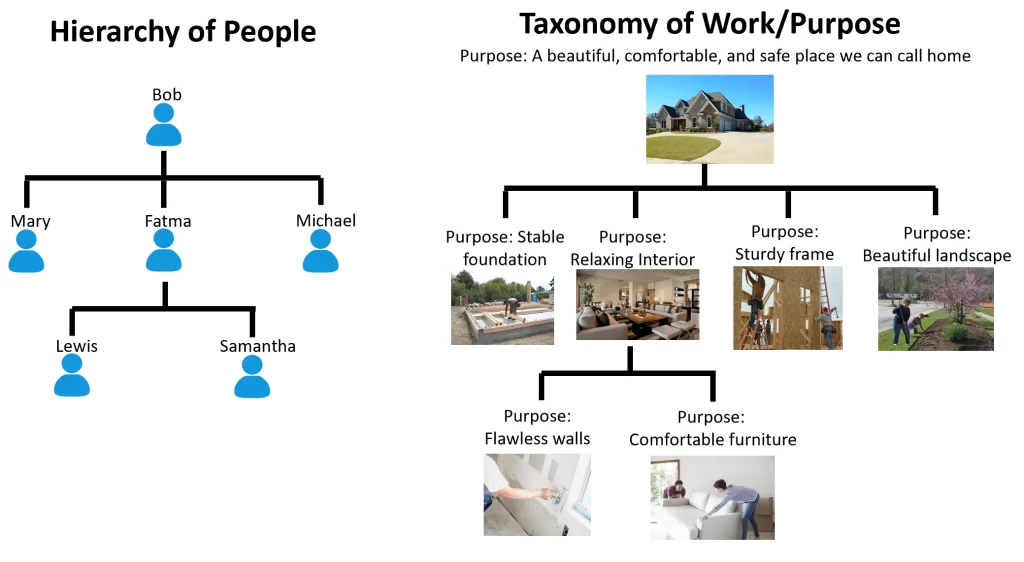
One of the misconceptions and hype of Holacracy is that there is no longer a need for management or leaders. This couldn’t be further from the truth. What is closer to the truth is that managers are replaced by a system of management that everyone uses and leaders are propagated and cultivated throughout the organization. In Holacracy, these functions are distributed rather than centralized in just a few people.
For leaders new to the world of self-management it’s not always clear how to lead in Holacracy or what levers are available to move the organization toward achieving its goals. This gap in knowledge combined with a fear of breaking the rules of Holacracy by over managing can lead to leaders not actually leading. This is especially true for leaders that were managers, section chiefs, or supervisors before and now find themselves in a Lead Link role in Holacracy.
So, how do you lead in Holacracy? What are those levers that you have as a leader and how do you use them appropriately? There are multiple levers in Holacracy to lead your organization. However, these are the four primary levers I think about when it comes to creating organizational alignment and leading the team to achieving the organizational outcomes.
Lever 1: Organizational Structure
The very first accountability of the Lead Link role is “Structuring the Governance of the Circle to enact its Purpose and Accountabilities.” The Lead Link, more so than any other role, is accountable for the ensuring the collection of roles, accountabilities, policies, and domains are sufficient to achieve the purpose or organizational outcomes.
The way to think about this is to ask yourself these questions: Does the articulated purpose of the circle make sense? Does it convey the “what we should be doing” and “why it’s important” for the circle? In purpose driven systems everything starts with the purpose statement. It doesn’t have to be perfect, it just needs to be directionally correct and minimally sufficient to help in the next step.
The next step is unpacking that purpose into smaller parts. You can also think about it in terms of the work that needs to be done to achieve the purpose of the circle. What is the work that we need to do in order to achieve that purpose? Some of the work may be fairly small while other work might be pretty big. The small work will become roles while the larger chunks of work becoming sub-circles to be further broken down. Each of these roles and circles will have a purpose. The best purpose statements convey the: 1) aspirational outcome desired and 2) why that outcome is important. Much like in biology where the classification of living world is classified in a taxonomy of increasing more specific characteristics, the taxonomy of purpose is also broken down into increasingly more specific outcomes.
If it helps, you can also think about it as the hierarchy of work. There is a larger purpose an organization aims to achieve. There is work required to fulfill that purpose. This work can then be broken down into its parts with each having a sub-purposes describing the aspirational outcome in support of the larger purpose.

So, as a leader in a Holacracy powered organization, you should be reviewing the circle purpose, its accountabilities, the roles with their purpose and asking yourself “does this structure make sense, capture all of the work to achieve the circle purpose, and does it provide people with directional information?” If it doesn’t then you should be proposing governance so that it does.
Actions for you
- Review your circle purpose. Does it make sense to you? Can you envision desired outcomes for the organization as stated?
- Review roles and circles in your circle. Do they capture the work that is needed to be done in order for your circle to achieve its purpose or outcomes? Does each role and circle have a purpose that conveys both aspirational outcomes as well as why it’s important? Are the purposes actionable? Meaning, for those filling the role, is it clear to them what the work of the role should be? Ask them.
Lever 2: Strategies
One of the accountabilities listed for Lead Links is “Establishing priorities and Strategies for the Circle.”
Strategies are usually significantly under utilized in early practice of Holacracy. They also have a slightly different meaning than what we’re traditionally used to as well. The purpose of strategies in Holacracy is to provide people some additional information about what’s important as they try to prioritize all that they have to do. There is always more work than time and we often don’t have much choice on what we can work on. Strategies convey what people should be focusing on when they have choice to do so.
As a leader you should be asking: what are the things I want the team to focus on and what prioritization guidance would be the most helpful for the team? The first part of the question is a self-reflection. The second part of the question implies you should be asking the team for their input. Unlike the purpose of a Circle, strategies do not require governance meetings. You can add, change, and delete strategies whenever you want. This gives you the freedom to change or improve them frequently. This is another place where you don’t have to be perfect. Come up with strategies that make sense to you and helpful for the team and try them out for awhile. After a couple weeks ask the team: are these strategies helpful in guiding your prioritization?
Generally speaking, you want strategies to have a lifespan of at least a few months but don’t be afraid to change them regularly to improve their usefulness. It’s also OK to have more than one strategy but the fewer the better. I generally try to keep them to two to three strategies.
Actions for you
- Review the strategies of the circle. Do they align and support strategies of the parent circle?
- Ask circle members if the strategies are helpful in their own prioritization of work.
- Update and experiment with strategies
Lever 3: Requesting Next Actions and Projects
Requesting Next Actions and Projects can be difficult and awkward in many ways. It can be awkward because this is where leaders may feel like they are micro-managing and directing rather than leading. However, requesting Next Actions and Projects is a primary method for getting work done and making progress towards organizational outcomes. The difference in Holacracy anyone can request Next Actions and Projects of anyone else. Section 4.1 of the Constitution is your friend. Know it and memorize it.
In a typical hierarchical setting, the manager directs employees to take on an Next Action or Project. This is because the manager owns the work of the team and holds the purpose and accountabilities for everyone on the team. As they assign work they are implicitly deciding if the work makes sense for the team and the position that should be tasked. Although there is usually a Position Description describes the position, these descriptions are usually very broad and include “other duties as assigned.”
In Holacracy, there isn’t a manager that holds the purpose and accountabilities. Instead, that is the authority of the person filling the role. So, before work can be assigned to a role there is still a need to ensure it makes sense for the role in question. How you ask for a role to take on a Next Action or Project and how that request is processed is different in Holacracy.
Where does the work belong based on our current governance? Technically, in Holacracy, you are not just asking a role to take on a Next Action or Project; you are first asking if a Next Action or Project makes sense or is reasonable for a role to take on. Does it serve the purpose of the role? Is this right place for this work? [Constitution 4.1.2(b)] They then have the ultimate authority to assess whether the work aligns with the role. Does the request serve the purpose of the role?
The role holder can only say “no” if they honestly believe that the role is not the right place for this work. You can pitch why you think it’s the right place by pointing out accountabilities of the role or purpose but ultimately, the role holder has the final say as to whether it’s the right place for the work. If the answer is still “no” then that points to a lack of clarity or gap in governance and either an accountability needs to be added to a role or a new role created to capture where that work should live.
Often someone will say “no” because they are worried about taking on more work but this an incorrect response. Prioritization is a separate issue. In the early stages of Holacracy practice it’s common to believe that saying “yes” to a request implies that the request must then be worked on immediately or is, in someway, being prioritized. This is not the case. Responding with “yes, it makes sense for my role” only clarifies that the work aligns with the purpose of the role. The work belongs in this part of the organization. Prioritization is a completely different question and a separate conversation. Once it’s clear where the work lands, then you can ask for projections for the work to be completed and triage prioritization issues.
It’s perfectly OK to ask for projection and role fillers are expected to provide them [Constitution 4.1.1(c)]. Providing a projection isn’t a commitment; it’s a best guess based on current information. It’s data that you can use to determine if further discussion is needed. Perhaps a need to triage prioritization, identify impediments, or developing workarounds if the projection doesn’t meet your needs. Asking for a projection is one of those actions that may feel like micro-managing but the micro-management doesn’t come from asking, it comes from how you react to the information. If a projection is provided that doesn’t meet your needs, ask clarifying questions to understand what is driving the date. Likely causes include: 1) there is other work they are doing that they understand to be more important, 2) their understanding of the work is much larger in scope than yours, and 3) there are things outside of their control that they are waiting on and blocking completion. In all of these cases, a conversation can create clarity and discover an approach to get you what you need.
Actions for you
- Review Constitution section 4.1, print it out and put it somewhere you can easily reference. Commit it to memory.
- Review the projects in GlassFrog. Are all of the projects you care about listed there? If not, then ask for them to be added.
- Learn and practice the format for asking someone else to take on an action or project. “John, does it make sense in your role [role name] to take on a project/action to do [whatever you need]? Or, if your not sure about the role, “John, does it make sense, in one of your roles, to take on ….?”
- Identify any projects that you care about but you feel like there isn’t forward momentum and ask: “John, what is your projection for [project x]?” If they don’t have a projection: “John, can you record a next action to come up with a projection and share it with me?”
Lever 4: Metrics
You get what you measure. If you don’t measure it you can’t improve it. Just because you can measure it doesn’t mean it’s important. Just because it’s important doesn’t mean you can measure it.
These are some of my favorite sayings about metrics. Having the right metrics can be very helpful in knowing how the organization is doing as well as communicate what is important.
As a Lead Link one of the articulated accountabilities is “Defining metrics for the circle.” You can do this without a Governance meeting and whenever you like. It is completely your authority to create the metrics needed to help you measure whether the Circle is achieving its purpose. The best metrics are ones that directly relate to the Purpose of the circle and the circle’s accountabilities. Look at the Purpose of the Circle and ask yourself the question: “How do I know we’re making progress on this?” Look at each accountability and ask a similar question: “How well are we doing this?”
In any organization, Holacracy or otherwise, metrics can be a tricky thing. There is a tendency to measure something simply because it’s easy to measure. However, a small number of meaningful metrics are significantly more useful than a lot of metrics. Finding that balance can be hard but just like the instrument panel of an airplane, metrics tell you whether you are making progress on the things that are important and are achieving your purpose. A dashboard of metrics can be a great early indicator of issues. In addition, the most useful metrics are ones that are in a time series so that you can see trends and metrics that are displayed visually so that you can digest the information more quickly.
Actions for you
- Review your Purpose statement and ask yourself the question: “What metric would let me know if we are making progress towards the purpose?”
- Review each accountability and ask yourself the question: “How do I know we are delivering on this accountability?”
- Review existing metrics and remove those that aren’t contributing to the answer above. Too many metrics create work and diffuse attention.
Once you become comfortable using these four levers you will be well underway to leading effectively in Holacracy. There are other levers not covered here but you will encounter those naturally. Keep in mind that learning how to lead in a self-management environment is exercising a muscle you’re not used to using. It will take practice and patience.
To learn more about self-management, join a community of pioneers and check out our e-learning suite → Self-Management Accelerator

